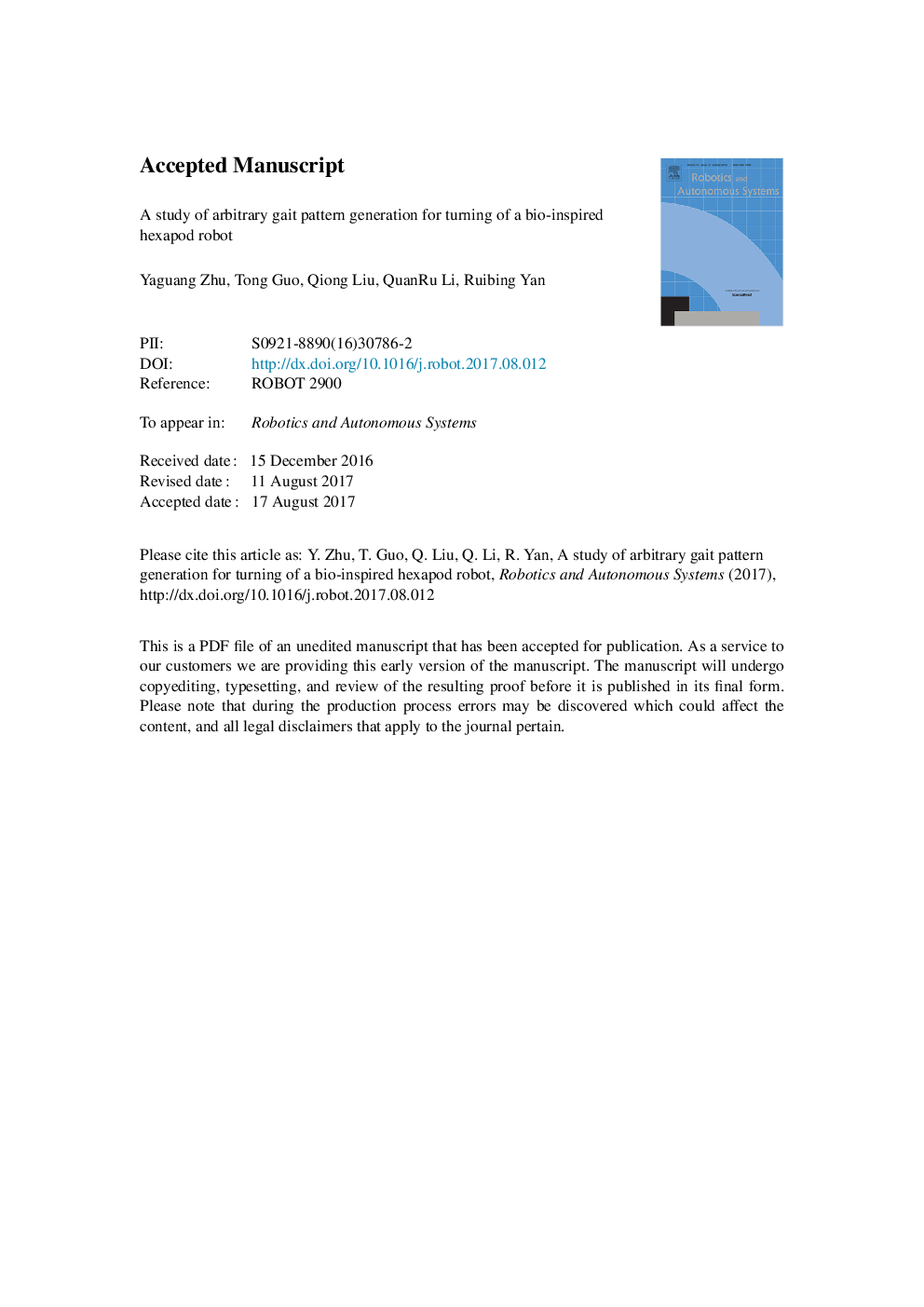| کد مقاله | کد نشریه | سال انتشار | مقاله انگلیسی | نسخه تمام متن |
|---|---|---|---|---|
| 4948687 | 1439845 | 2017 | 18 صفحه PDF | دانلود رایگان |
عنوان انگلیسی مقاله ISI
A study of arbitrary gait pattern generation for turning of a bio-inspired hexapod robot
ترجمه فارسی عنوان
مطالعهی الگویی برای ساختن الگوی راه رفتن دلخواه برای تبدیل یک روبات هگزاپود الهام گرفته از زیست شناسی
دانلود مقاله + سفارش ترجمه
دانلود مقاله ISI انگلیسی
رایگان برای ایرانیان
کلمات کلیدی
ربات هگزاپود بیو الهام گرفته، پیچ، الگوهای اتفاقی خودسرانه، نگرش،
ترجمه چکیده
الگوی چرخش شعاع ثابت می تواند به یک حرکت همه جانبه هدایت شود، در حالیکه ربات گیت های مختلف را انتخاب می کند، برای ساخت الگوریتم کنترل متفاوت ناکارآمد است. بنابراین برای ساده کردن فرایند راه رفتن و گسترش دادن چندین گیت معمول به مسیرهای دلخواه در هنگام تبدیل یک روبات هگزاپود الهام گرفته از زیست شناسی، الگوریتم تولید الگویی برای الگوی راه رفتن خودسرانه پیشنهاد شده است. این الگوهای راه رفتن از طریق تنظیم فاز چرخش و مرحله حمایت از هر پا با توجه به ویژگی های گیت های مختلف برنامه ریزی شده است، که تنها با ضریب گیم کنترل می شود. این الگوریتم نه تنها می تواند الگوهای رفتاری چرخش را گسترش دهد، بلکه مشکل برنامه ریزی را نیز کاهش می دهد. علاوه بر این، حداکثر زاویه چرخش تحت شعاع های مختلف چرخش از نظر محدودیت هندسی و حاشیه ثبات محاسبه می شود. یک سری آزمون برای اعتبارسنجی الگوریتم انجام می شود. نتایج نشان می دهد که روش پیشنهادی مؤثر است و دارای عملکرد خوبی بر پایداری ربات است که پایه ای برای تحقیقات بعدی برای جلوگیری از موانع و حرکات مستقل است.
موضوعات مرتبط
مهندسی و علوم پایه
مهندسی کامپیوتر
هوش مصنوعی
چکیده انگلیسی
Constant radius turning pattern can be extended into an omnidirectional movement, while it is inefficient to build different control algorithm when the robot chooses different gaits. So in order to simplify the process of gait generation and extend several typical gaits into arbitrary gaits during turning of a bio-inspired hexapod robot, taking insect gait as inspiration, an arbitrary gait pattern generation algorithm is proposed. These gait patterns are planned through adjusting the swing phase and support phase of each leg according to the features of different gaits, which is only controlled by gait coefficient. This algorithm can not only greatly expand the gait patterns of turning, but also reduce the difficulty of planning. In addition, the maximal turning angle under different turning radiuses is calculated by the geometric constraint and stability margin condition. A series of tests are carried out to validate the algorithm. The results show that the proposed method is effective and have good performance on stability of the robot, which provides the basis for subsequent research of avoiding obstacles and autonomous locomotion.
ناشر
Database: Elsevier - ScienceDirect (ساینس دایرکت)
Journal: Robotics and Autonomous Systems - Volume 97, November 2017, Pages 125-135
Journal: Robotics and Autonomous Systems - Volume 97, November 2017, Pages 125-135
نویسندگان
Yaguang Zhu, Tong Guo, Qiong Liu, QuanRu Li, Ruibing Yan,
